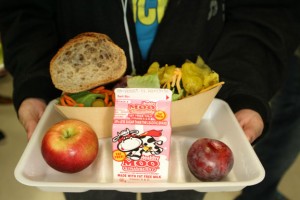Naugatuck school board opts for districtwide participation in federal program

NAUGATUCK — Naugatuck schools will offer free lunch and breakfast to all students in the coming school year through a federal program, and officials are hoping they’ll take advantage of it.
The Board of Education has decided to participate in the Community Eligibility Provision (CEP) districtwide. CEP, which is administered by the U.S. Department of Agriculture, is a “non-pricing meal service option for schools and school districts in low-income areas,” according to the USDA website. The program allows schools to provide free breakfast and lunch to all students without applications, and receive federal reimbursement for the meals.
Typically, parents apply for free or reduced meals for their children. Some children are directly certified for free meals based on several socioeconomic factors, including being homeless, in foster care and coming from families that receive Supplemental Nutrition Assistance Program, Temporary Assistance for Needy Families or Medicaid.
By implementing CEP across the district, parents won’t need to apply for free or reduced meals and all students, regardless of their socioeconomic status, are eligible for one breakfast and one lunch a school day at no charge.
“This levels the playing field, nobody has to worry about who has the money and who doesn’t have the money,” Superintendent of Schools Sharon Locke said.
The full cost of lunch ranges from $2.70 at the elementary schools to $3.45 — depending on the option — at Naugatuck High School. Breakfast costs $1.75 at the high school and $1.10 for younger students.
Schools qualify for CEP when 40 percent of their students are directly certified for free meals. Districts can also group schools together or implement CEP districtwide, however the level of federal reimbursement is based on the percentage of directly-certified students. So, schools with lower percentages mean less reimbursement.
That is the scenario borough school officials are working with in the 2019-20 school year.
Andrew Avenue Elementary School and Salem Elementary School were the first schools to participate in CEP in the 2017-18 school year. More schools were added the following school year, and officials initially sought to add Naugatuck High School and City Hill Middle School in the coming school year.
That would have left Maple Hill Elementary School and Cross Street Intermediate School as the only two Naugatuck schools not in the program, and the school board urged the administration to include every school.
About 33 percent of Maple Hill and Cross Street students are directly certified for free meals. Including the schools brings down the district’s overall percentage, which means less reimbursement. This raises a potential financial problem. Sodexo, which runs the cafeteria program for the district, is meant to be self-sustaining and gets paid through reimbursement for meals and direct sales.
With all students eligible for free meals, Business Manager Bernice Rizk said the program may come at a cost if Sodexo loses money because it’s the district’s responsibility to make the company whole.
The district will have to increase the number of meals served to avoid an expense. Rizk said the number of breakfasts served needs to increase by 43 percent, while the number of lunches has to go up by 23 percent. That equates to 76,014 lunches and 38,387 breakfasts served a month.
Naugatuck schools where CEP was implemented saw increases in participation in the breakfast and lunch programs that met those thresholds. In the first three months CEP was implemented, breakfast participation increased 122 percent and lunch participation increased 24 percent, according to statistics provided by Rizk.
“We are hoping this is going to be the case when we add everybody,” she said.
Rizk said officials are working to raise awareness about the program among parents and plan to implement several initiatives to encourage higher participation.
At the high school, for example, Rizk said officials found some students don’t get lunch because the cafeteria is too crowded during lunch waves. She said kiosks will be added in the cafeteria to help alleviate the crowds. Also, she said, a breakfast kiosk will be added near the athletic fields for students to grab breakfast as they head into school in the morning.
In a district where about half the students face socioeconomic challenges, Locke said CEP creates an environment where students that have the money or don’t for meals are indistinguishable.
Locke added the program also alleviates the issue of trying to collect unpaid lunch balances.
“We want the school’s relationship with our families to be nothing but positive and this just takes one more barrier off the table,” she said.














Free if your not working on welfare.
Otherwise it’s surly coming out of your paycheck under the Federal deductions
category. Never ends.
All for the Democrat vote to sustain this lazy, broke class they have created.